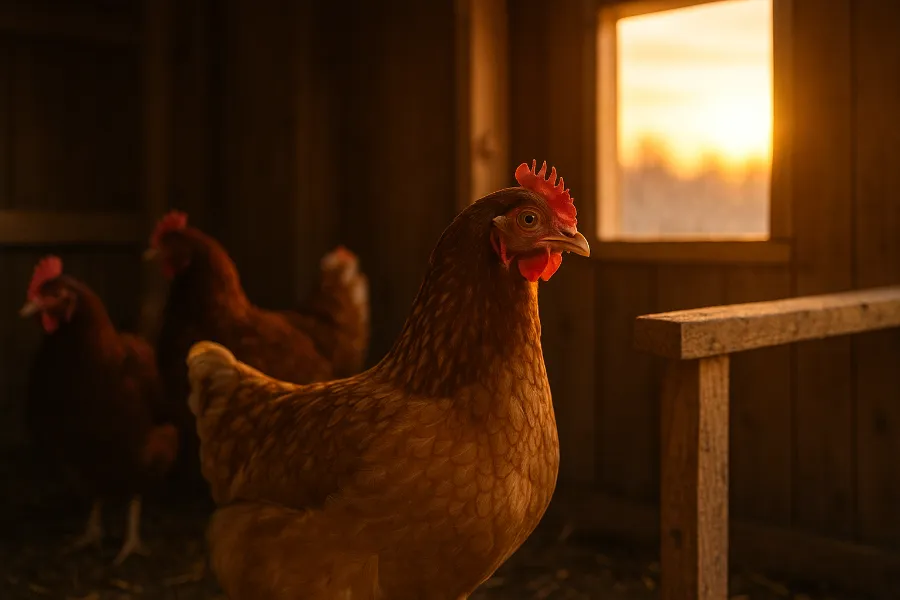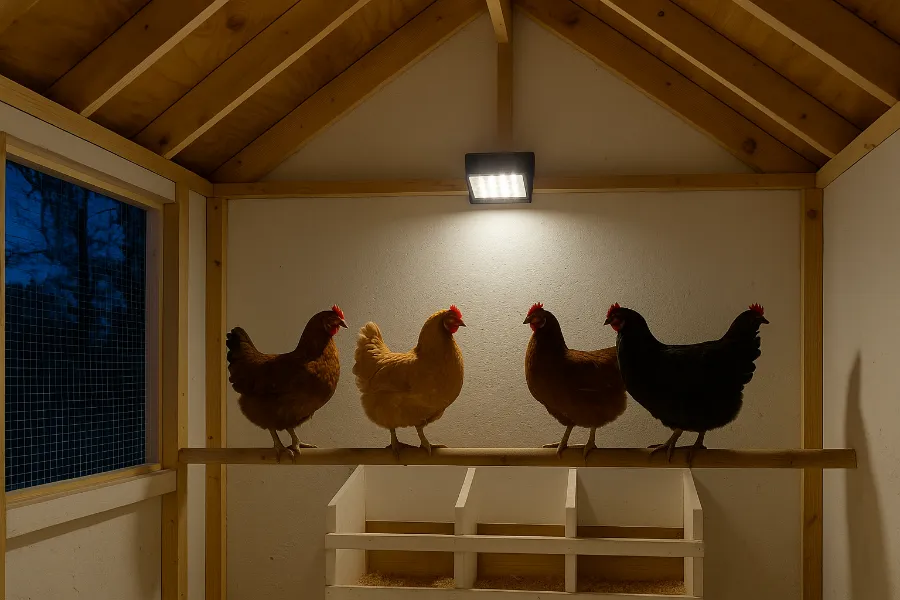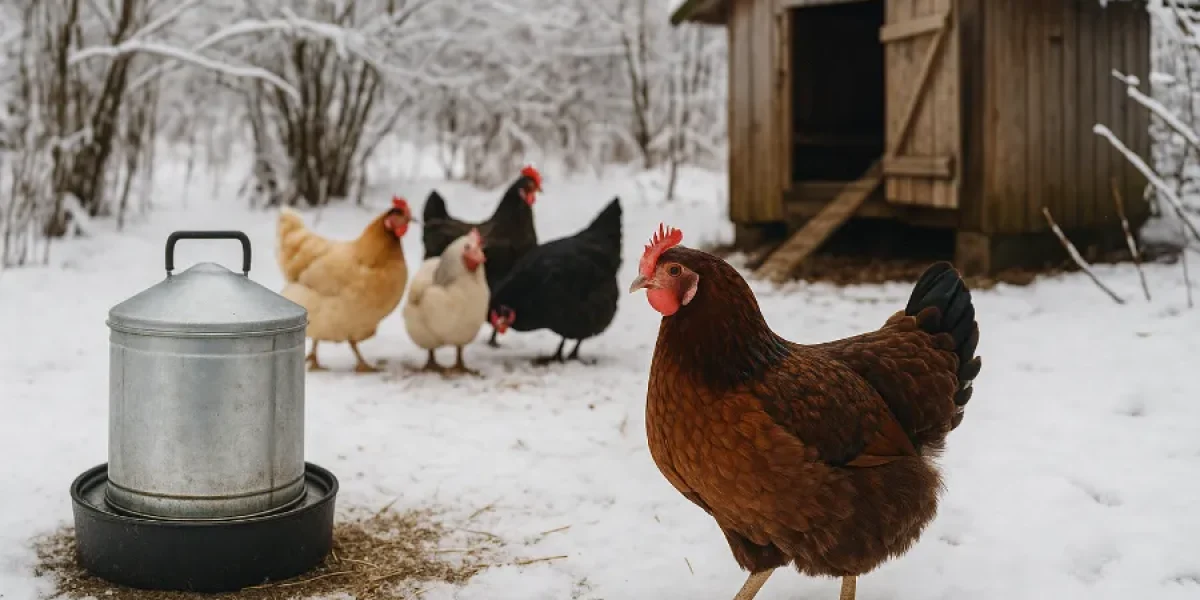Every year when the first frost hits, I notice the same thing—the hens slow down. Egg baskets that were full in summer start looking empty. Some mornings, the waterers are frozen solid, the coop feels damp, and I can almost hear my flock asking, “Do we really have to get up today?”
That’s when I’m reminded how much small details matter in winter—light, warmth, water, and comfort. And among all the fixes I’ve tried over the years, one tool has truly changed everything: the heated poultry waterer.
If you’re wondering why hens stop laying eggs in winter and how to fix it, this post is for you. I’ll walk you through exactly what’s happening with your flock, how to help them naturally, and which upgrades—from budget DIYs to premium coop systems—actually make a difference.

Why Hens Stop Laying Eggs in Winter
When hens stop laying eggs in winter, it isn’t laziness—it’s biology. Their bodies respond to shorter days, colder nights, and changing hormones. Here’s what’s really happening inside that cozy coop of yours.
Less Daylight, Fewer Eggs
Hens rely on sunlight to trigger egg production. They need about 14 to 16 hours of light per day to maintain their laying rhythm. Once daylight dips below that threshold, the signal to produce eggs slows down.
Nature designed it that way—chicks born in mid-winter wouldn’t survive. But with a few small tweaks, we can safely “extend” daylight and help hens lay consistently through the cold months.
Cold Weather and Energy Drain
When temperatures drop, hens use most of their energy just to stay warm. That means fewer calories go toward making eggs. Even the best layers take a seasonal pause if their environment is too cold or drafty.
Molting and Rest Cycles
Many hens molt in late fall, shedding feathers to grow new ones before the cold sets in. Feathers require protein to grow, so hens redirect energy from egg production to feather growth. Think of it as a natural reboot for the next laying season.
Frozen Water, Frozen Production
This one surprises new keepers: when water freezes, everything else stops too. Without steady hydration, hens won’t eat as much feed—and without enough feed, egg production halts. That’s where a heated poultry waterer makes all the difference. It’s the simplest, most effective fix for one of winter’s biggest obstacles.
Heated Poultry Waterer: My Winter Must-Have
If I could only invest in one winter upgrade, it would be a heated poultry waterer. I’ve carried enough buckets of hot water through snow to know the pain of dealing with frozen drinkers.
A heated poultry waterer keeps water liquid even during freezing temperatures, ensuring your hens stay hydrated and healthy all season long.
How It Works
Most models use a thermostatic heating element in the base or along the sides. When the temperature drops below 35°F, it automatically warms the water just enough to prevent ice formation.
There’s no boiling, no risk of overheating—just steady, comfortable water supply that your flock can rely on.
Best Options by Budget
| Price Range | Product Type | Ideal For | Notes |
|---|---|---|---|
| Budget DIY | Heated pet bowl or DIY base with seed-starting mat | Small backyard flocks | Cheap, effective for mild winters |
| Mid-Range | Plug-in heated poultry waterer with thermostat | Average backyard setup | Easy to clean, safe in most coops |
| High-End | Solar-powered heated waterer with auto sensors | Off-grid coops or large flocks | Eco-friendly, no cords, higher upfront cost |
Safety Tips
- Always use outdoor-rated cords and plug them into a GFCI outlet.
- Keep cords off the ground to avoid moisture.
- Avoid cheap heat lamps near bedding—use only equipment made for poultry.
- Check the water daily; even heated units need refilling more often in cold air.
When you solve the water problem, you’ve already solved half the winter egg problem.

LED Lights for Chicken Coop: Keeping the Sun Shining
The next biggest winter challenge is light—or rather, the lack of it. Hens’ laying cycles are triggered by daylight, so when the days shorten, egg output drops.
Adding LED lights for your chicken coop is the simplest and safest way to extend “daytime” hours without overheating your birds or breaking the bank.
How to Set Up Winter Lighting
- Use warm-white LED bulbs around 2700K–3000K (soft and natural).
- Set a timer so the lights turn on a few hours before dawn.
- Aim for a total of 14 to 16 hours of light daily.
Avoid turning lights on at night suddenly—it confuses hens and disrupts their rest. Morning light is gentler and mimics sunrise.
Options by Budget
- Budget: Clip-on LED shop light with a timer plug.
- Mid-range: Dimmable LED panels with automatic sunrise simulation.
- High-end: Programmable smart lighting systems for precision daylight cycles.
Light doesn’t have to be complicated—it just has to be consistent.
Solar-Powered Chicken Coop Light: Off-Grid and Energy-Smart
If your coop doesn’t have access to electricity, a solar-powered chicken coop light can be a game-changer. I switched to solar a few years ago, and it’s been both cost-effective and sustainable.
Why I Love Solar Lights
- No wiring or electrical hazards.
- Lower energy costs.
- Perfect for remote or mobile coops.
Mount the solar panel on the south-facing roof, and position the LED fixture inside the coop where it diffuses evenly. Many systems now come with remote controls and backup USB charging, making them versatile even in cloudy stretches.
Deep Litter Method for Chicken Coop: Free Warmth, Less Work
I used to clean my coop weekly in winter—until I discovered the deep litter method for chicken coops. It’s now one of my favorite cold-weather hacks.
How It Works
Instead of removing bedding each week, you let it build up layer by layer. The bottom layers begin to compost, generating gentle heat that keeps the coop naturally warm.
Start with 4–6 inches of pine shavings or straw, add new layers regularly, and stir it occasionally with a rake. In spring, you’ll have rich compost ready for the garden.
Benefits
- Natural insulation.
- Minimal cleaning through winter.
- Odor control and moisture balance.
- Free fertilizer when you’re done.
It’s warm, budget-friendly, and pairs beautifully with your heated poultry waterer and solar lighting system.
Winter Chicken Care: Balancing Warmth, Water, and Light
When people ask about winter chicken care, I always say it’s less about heat and more about balance. Chickens handle cold better than drafts or dampness. The secret is to keep them dry, hydrated, and gently lit.
My Winter Care Routine
- Early light: Timers turn on my LED coop lights before sunrise.
- Warm bedding: I refresh the deep litter weekly.
- Fresh water: My heated poultry waterer keeps everything flowing.
- Extra protein: Black oil sunflower seeds and mealworms support feather regrowth.
- Check vents: I ensure there’s airflow without drafts.
Keeping things predictable helps your flock stay calm and consistent through winter.
How to Keep Chickens Warm Without Heat Lamp
Heat lamps might sound helpful, but they’re risky. One broken bulb or spark near bedding can turn your coop into a disaster.
So, how do you keep chickens warm without a heat lamp?
Better Ways to Stay Warm
- Deep litter method for natural ground heat.
- Insulated coop walls lined with cardboard or foam board.
- Heated perches or radiant panels (safe, low-energy warmth).
- Group roosting—hens share body heat naturally.
Avoid over-sealing your coop. Moisture buildup is far worse than cold air. Chickens handle cold—but damp feathers spell trouble.
Old to New Coops: Design Upgrades That Matter
Whether your coop is a decades-old shed or a brand-new prefab, winter always reveals the weak spots. Here’s how I’ve upgraded over time—starting with almost no budget and slowly working my way up.
Old Coop, Tight Budget
When I first started, I used an old garden shed. I sealed cracks with burlap feed bags, painted the inside white to reflect light, and hung a cheap LED bulb on a timer. My “heated poultry waterer” was a DIY setup with a seed-starting mat under a metal pan—and it worked.
Mid-Range Upgrades
Later, I added solar panels, a store-bought heated waterer, and automatic doors to keep out drafts. It made daily chores smoother and safer.
Modern High-End Coops
These days, some coops come fully equipped—solar-powered lighting, climate-controlled ventilation, even app-controlled thermostats. They’re incredible, but the same principles still apply: light, airflow, dry bedding, and steady water.
Even the fanciest coop can’t replace good care—but it sure can make it easier.

Do’s and Don’ts for Winter Chicken Care
A simple checklist for why hens stop laying eggs in winter and how to fix it—no matter your budget.
Do:
- Use a heated poultry waterer to prevent freezing.
- Keep 14–16 hours of light daily (LED or solar).
- Feed high-protein, mineral-rich diets.
- Use the deep litter method for free insulation.
- Maintain proper ventilation above roost height.
Don’t:
- Don’t use unguarded heat lamps.
- Don’t let water freeze overnight.
- Don’t block all airflow—moisture kills faster than cold.
- Don’t rely on corn as the main feed—it warms but lacks nutrients.
- Don’t overcrowd your coop in winter.
The Real Fix: Support Nature, Don’t Fight It
Winter doesn’t have to mean empty nesting boxes. Once you understand why hens stop laying eggs in winter and how to fix it, the solutions feel simple—hydration, light, warmth, and peace.
A heated poultry waterer ensures constant hydration. LED lights or solar-powered chicken coop lights keep natural cycles active. The deep litter method offers cozy warmth from the ground up. And together, they create an environment where hens can thrive, even in the coldest months.
My coop may not be fancy, but it’s balanced—and that’s what keeps those golden yolks showing up in my basket, even when snow’s on the ground.
FAQs
Hens slow down egg production in winter because of shorter daylight hours and colder temperatures. Their bodies naturally rest until conditions improve.
A heated poultry waterer keeps water from freezing, ensuring hens stay hydrated. Proper hydration helps maintain healthy digestion and consistent egg laying.
Hens need about 14 to 16 hours of light daily. Supplemental LED or solar-powered coop lights can safely extend daylight hours to support egg production.
It’s a winter bedding technique where you layer shavings or straw, letting it compost over time. This process generates natural warmth and reduces cleaning.
Yes, use insulation, the deep litter method, heated perches, or safe radiant panels. Avoid heat lamps—they’re fire hazards and can overheat your coop.
Add insulation, seal drafts, install LED or solar lights, and use a heated poultry waterer. Even small updates can make older coops more efficient and comfortable.
Increase protein with mealworms or black oil sunflower seeds and provide extra calcium. A balanced diet supports feather growth and egg consistency.













